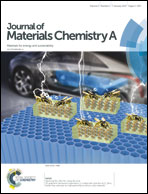Surface charge transfer doping induced inversion layer for high-performance graphene/silicon heterojunction solar cells†
Abstract
Graphene/silicon heterojunction solar cells have stimulated enormous research interests due to simple device architecture and low-cost solution-processing capability. Graphene can serve as p-type layer to form heterojunction with n-type crystalline Si. However, improvement of device performance is hindered by the relatively low junction height arising from the small work function of graphene. Herein, for the first time, we develop and implement a surface inversion layer on Si substrates by surface charge transfer doping (SCTD) scheme using a layer of high work function metal oxide (MoO3) as a hole injection layer on Si surface. Spontaneous hole injection from the MoO3 layer to Si led to the generation of a hole inversion layer on Si surface, greatly enhancing the built-in electric potential and suppressing the carrier recombination. The use of SCTD method, in combination with additional device optimization by graphene doping and polymer anti-reflection coating, results in a high power conversion efficiency approaching 12.2%. The SCTD scheme provides a new platform to further enhance the performance of graphene/silicon heterojunction solar cells.


 Please wait while we load your content...
Please wait while we load your content...